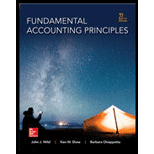
Concept Introduction:
Organizational activities: Organizational activities are the activities those are performed to maintain the operation of a business. Financing, investing or operating activities are three major organizational activities.
Operating activities: Operating activities includes regular business activities such as cash received from sale of products, supplier payments, client servicing.
Investing activities: Investing activities are performed for buying and selling of assets such as building, machinery.
Financing Activities: Financing activities are performed for arranging or repaying, equity or debt such as payment of dividends, cash received from owner.
To Describe: The organizational activities and outline the major business activities and give two examples for each.
Trending nowThis is a popular solution!

Chapter 1 Solutions
Fundamental Accounting Principles -Hardcover
- General accountingarrow_forwardOn January 1, Year 6, Howard, Inc., granted to a key executive a fixed compensatory share option plan for 1,000 shares of $4 par common stock for $30 a share. The fair value per option on that date was $14. The service period extended through December 31, Year 7. What entry, if any, was required on December 31, Year 6? a. Compensation Expense 7,000Paid-in Capital from Share Options 7,000 b. no entry necessary c. Compensation Expense 6,000Paid-in Capital Share Options 6,000 d. Compensation Expense 9,000Deferred Compensation 9,000arrow_forwardCould you explain the steps for solving this general accounting question accurately?arrow_forward
- Solve thisarrow_forwardMelford Industries sells a product to a wholesaler for $52. The wholesaler applies a 30% markup based on selling price when selling to a retailer. The retailer then applies a 40% markup based on selling price to determine the final price to the consumer. What is the final selling price to the consumer?arrow_forwardWhat is the estimated variable cost per machine hour?arrow_forward
- If the liabilities of Redwood Enterprises increased $75,000 during a period of time and the owner's equity in the business decreased $30,000 during the same period, the assets of the business must have__. 1. Decreased $105,000 2. Increased $45,000 3. Increased $105,000 4. Decreased $45,000 answerarrow_forwardMelford Industries sells a product to a wholesaler for $52. The wholesaler applies a 30% markup based on selling price when selling to a retailer. The retailer then applies a 40% markup based on selling price to determine the final price to the consumer. What is the final selling price to the consumer? Answerarrow_forwardI need help finding the accurate solution to this financial accounting problem with valid methods.arrow_forward

 AccountingAccountingISBN:9781337272094Author:WARREN, Carl S., Reeve, James M., Duchac, Jonathan E.Publisher:Cengage Learning,
AccountingAccountingISBN:9781337272094Author:WARREN, Carl S., Reeve, James M., Duchac, Jonathan E.Publisher:Cengage Learning, Accounting Information SystemsAccountingISBN:9781337619202Author:Hall, James A.Publisher:Cengage Learning,
Accounting Information SystemsAccountingISBN:9781337619202Author:Hall, James A.Publisher:Cengage Learning, Horngren's Cost Accounting: A Managerial Emphasis...AccountingISBN:9780134475585Author:Srikant M. Datar, Madhav V. RajanPublisher:PEARSON
Horngren's Cost Accounting: A Managerial Emphasis...AccountingISBN:9780134475585Author:Srikant M. Datar, Madhav V. RajanPublisher:PEARSON Intermediate AccountingAccountingISBN:9781259722660Author:J. David Spiceland, Mark W. Nelson, Wayne M ThomasPublisher:McGraw-Hill Education
Intermediate AccountingAccountingISBN:9781259722660Author:J. David Spiceland, Mark W. Nelson, Wayne M ThomasPublisher:McGraw-Hill Education Financial and Managerial AccountingAccountingISBN:9781259726705Author:John J Wild, Ken W. Shaw, Barbara Chiappetta Fundamental Accounting PrinciplesPublisher:McGraw-Hill Education
Financial and Managerial AccountingAccountingISBN:9781259726705Author:John J Wild, Ken W. Shaw, Barbara Chiappetta Fundamental Accounting PrinciplesPublisher:McGraw-Hill Education





